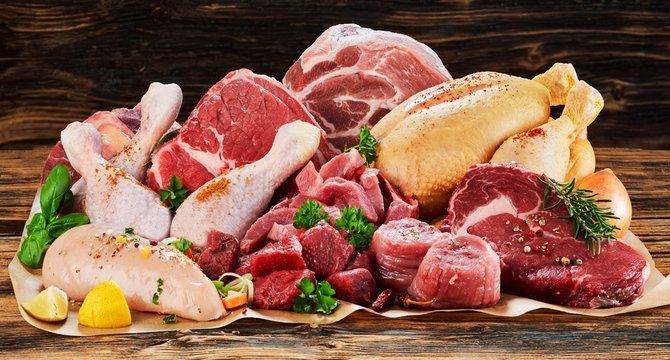The different nutrients in fish and meat
Which one is better?
When it comes to protein sources in our diet, fish and meat often take center stage. Both are excellent sources of essential nutrients, but their nutrient profiles differ significantly. Understanding these differences can help you make informed choices about which to include in your diet based on your health goals, nutritional needs, and personal preferences.
Protein Content
Fish
Fish is a high-quality protein source, providing all essential amino acids needed for muscle repair and growth. Varieties like salmon, tuna, and mackerel are particularly protein-rich.
- Lean Fish (e.g., cod, tilapia): Typically contain around 20-25 grams of protein per 3-ounce serving.
- Fatty Fish (e.g., salmon, sardines): Also provide about 20-25 grams of protein per 3-ounce serving, along with higher fat content.
Meat
Meat, including beef, pork, and poultry, is also a complete protein source with high biological value.
- Lean Meats (e.g., chicken breast, turkey): Contain around 25-30 grams of protein per 3-ounce serving.
- Red Meats (e.g., beef, lamb): Offer about 22-26 grams of protein per 3-ounce serving, depending on the cut and fat content.
Fat Content and Types
Fish
Fish, especially fatty fish, is rich in omega-3 fatty acids, which are beneficial for heart health, brain function, and reducing inflammation.
- Omega-3 Fatty Acids: Fatty fish like salmon, mackerel, and sardines are excellent sources, providing 1-4 grams of omega-3s per 3-ounce serving.
- Saturated Fat: Generally low in saturated fat compared to meat. Lean fish have minimal fat, while fatty fish have moderate amounts.
Meat
Meat's fat content varies widely depending on the type and cut, with significant differences in the types of fat.
- Saturated Fat: Red meats, particularly fatty cuts, can be high in saturated fat, which has been linked to heart disease. For example, a 3-ounce serving of ribeye steak can contain up to 10 grams of saturated fat.
- Monounsaturated and Polyunsaturated Fats: Present in smaller amounts compared to fish. Poultry with skin can provide a higher proportion of these healthier fats.
Vitamins and Minerals
Fish
Fish is a powerhouse of essential vitamins and minerals, especially those crucial for metabolic processes and overall health.
- Vitamin D: Fatty fish like salmon and mackerel are among the best natural sources, providing significant amounts of this essential vitamin.
- B Vitamins: Rich in B12, niacin, and B6, supporting energy production and nervous system health.
- Iodine: Particularly abundant in fish, essential for thyroid function.
- Selenium: Found in significant amounts, playing a role in antioxidant defense and thyroid function.
Meat
Meat is also nutrient-dense, offering a range of essential vitamins and minerals.
- Iron: Especially high in red meat (heme iron), which is more easily absorbed by the body compared to non-heme iron found in plant sources.
- B Vitamins: Rich in B12, B6, niacin, and riboflavin, supporting various bodily functions including energy production and red blood cell formation.
- Zinc: Abundant in meat, vital for immune function, DNA synthesis, and cell division.
- Creatine: Naturally occurring in meat, important for muscle energy production.
Health Considerations
Fish
- Heart Health: The omega-3 fatty acids in fish contribute to reduced risk of heart disease, lower blood pressure, and reduced inflammation.
- Brain Health: Omega-3s also support brain function and development, and may help prevent cognitive decline.
- Low in Saturated Fat: Beneficial for maintaining healthy cholesterol levels.
Meat
- Muscle Building: High-quality protein in meat supports muscle growth and repair, making it ideal for athletes and active individuals.
- Iron and B12 Source: Red meat is a particularly good source of easily absorbable iron and vitamin B12, preventing anemia and supporting overall energy levels.
- Saturated Fat Concerns: High intake of red and processed meats has been linked to increased risk of heart disease, certain cancers, and other health issues.
Environmental and Ethical Considerations
- Sustainability: Overfishing and certain fish farming practices can harm marine ecosystems, while meat production, especially beef, has a significant environmental footprint due to greenhouse gas emissions, land use, and water consumption.
- Ethics: Animal welfare concerns are prevalent in both commercial fishing and industrial meat farming, influencing some individuals to choose more sustainable and humane sources of protein.
Conclusion
Both fish and meat offer valuable nutrients and can be part of a balanced diet. Fish is particularly beneficial for heart and brain health due to its high omega-3 content and lower saturated fat levels. Meat provides robust protein, iron, and vitamin B12, supporting muscle development and overall vitality. When choosing between fish and meat, consider your health goals, dietary needs, and the broader environmental and ethical impacts. Balancing both, alongside plant-based proteins, can help ensure a well-rounded and nutritious diet.











